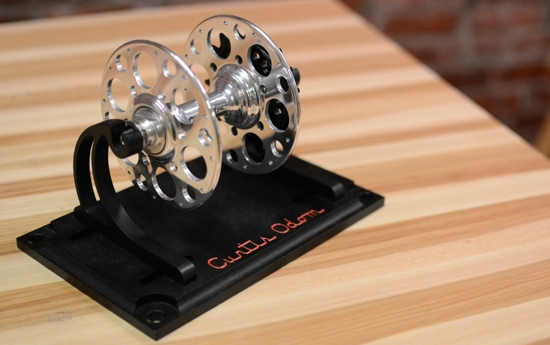
Melissa Bailey Photo
Ryan Taylor pulled out a glass decanter from a six-bay pour-over stand custom-made to look like a bicycle chain. He ground up 22 grams of Ethiopian Yirgacheffe. Then the chemistry began.
The experiment took place Monday at the corner of East and State streets in Ryan Taylor’s new Brooklyn-style, bike-themed coffee shop, the Coffee Pedaler. The shop features “pour-over” coffee, in which each cup of coffee is drip-brewed individually.

Taylor, who’s 31, opened the shop in October after serious renovations. Monday afternoon found him behind the coffee bar taking orders from rain-soaked regulars.
First he took out a coffee filter and placed it in a cone-shaped borosilicate glass “dripper.”

Then he took out a Hario V60 Buono stainless steel drip kettle with a long, slender spout. He brought it to a “manual hot water tower,” which is eternally bubbling with water at 97 degrees Celsius.

Then he brought the kettle back to the pour-over stand, which is shaped like a giant bicycle chain. It was designed by Curtis Odom, whose handiwork merges Taylor’s passions: coffee and bicycles.

Odom designs bicycle parts (like this hub, which holds the gear that makes the wheel turn).

Odom also designs coffee paraphernalia that mimics bicycle parts.
The equipment hints at the origins of Taylor’s coffee shop. It was born out of a shared passion for bicycles, he said. Taylor met his business partner when Taylor sold him a vintage bicycle frame on eBay. His business partner, who lives in New Jersey, bought the building at New Haven’s 605 East St., where Taylor opened his shop.
Taylor, of East Haven, worked in commercial refrigeration and HVAC for 12 years before entering the coffee biz. He caught the coffee bug a few years ago, when he walked into Gimme Coffee! in Brooklyn.
“It changed my life,” he said.

He employed his HVAC skills in renovating 605 East, which used to house a hair salon. He outfitted it with butcher-block hickory counters, handmade benches and a new floor. He hung four vintage bicycles on the wall.
With a scientist’s precision, Taylor poured hot water through the filter to get it ready for the coffee. He dumped out the water from the decanter and put it back on the bicycle-themed pour-over stand. (“Pour-over” means the water is poured over each individual serving, sometimes into a decanter, sometimes right into a cup.)

Then he opened a tin of Ethiopian Yirgacheffe Kochere GR1. GR1 stands for “Grade 1,” aka quality beans.
He measured 22 grams on a scale.

He put it into a Virtuoso Baratza grinder.
Grinding the coffee just before you drink it enhances the “flavor notes,” he explained.

He put the coffee in the filter. He started a timer. Then he delicately poured in an initial amount of water to let the grinds “bloom,” or soak. That releases the flavor, he explained.

After 30 seconds, the “bloom” was over, and he began to slowly pour water through the filter. The trick is to pour it at the right pace so that the whole brewing process takes about three minutes, he said.
After three minutes, he took out the filter.

He grabbed two 8‑ounce, porcelain cups from the top of the espresso machine, where they had been heating.
“Coffee likes stable temperatures,” he noted. If the cup is too cold, the coffee can get “shocked,” ruining the taste.
He poured two cups. He handed one to a reporter and held one up to his lips.
He detected an aroma of “lemon zest.”

Taylor and barista Patrick Dalton.
“Perfect,” he said.